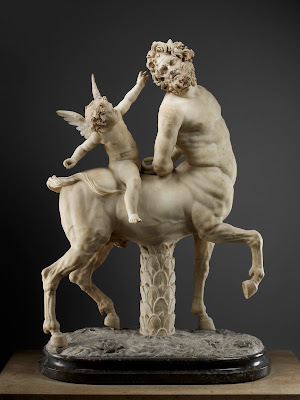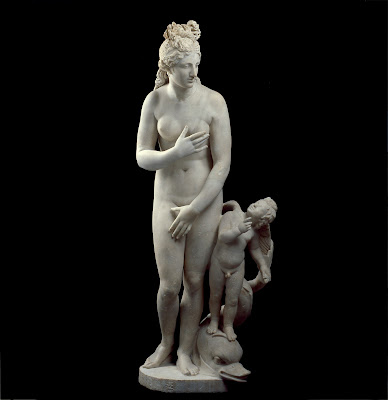In 1807, Prince Camillo Borghese was strong-armed by his brother-in-law, Napoleon Bonaparte, into selling him hundreds of works from the family collection. 695 pieces in all, most of them antiquities -sculptures, vases and reliefs- were packed up and carted off to France. The Romans of the time were in an uproar, and attempted to block the sale, but to no avail.
 |
| Vaso Borghese. Neo-attican school. End of 1st century BC. Louvre Museum, Paris. © Musée du Louvre, Etienne Revault |
Ennio Quirino Visconti, a famous antiquarian of the day, was responsible for selecting the most important works for the emperor. The crown jewel of the collection was the exquisite Borghese Vase, dating to the 1st century BC and discovered in the Orti Sallustiani. It will take your breath away the moment you cross the threshold of the already magnificent salon. It's impossible not to be awed by it, standing nearly six feet high and masterfully carved with delicate reliefs of Dionysian scenes. This one piece alone was valued at 200,000 francs at the time of purchase, about 1.1 million US dollars today. (I would wager its value is much higher today).
 |
| Silenus with the Child Bacchus, 1st-2nd cent. AD copy of 4th cent. BC original by Lysippus Louvre Museum, Paris. © Musée du Louvre, Thierry Ollivier |
It was a tragedy for Italy, but an even greater one for art. The antiquarians may have been the ones to select the art, but unfortunately they weren't always present during the removal of the works, and many sculptures were literally broken into pieces to fit them into the shipping crates. The sale price agreed upon was 13 million francs (circa 71.5 millions US dollars today), but in the end, just over half of this was ever paid. The rest was made up for by the gift of Lucedio estate in Piemonte.
 |
| Portrait of Lucius Verus. Head: ca. 180 AD, modern bust: Carlo Albacini. Louvre Museum, Paris. © Musée du Louvre, Daniel Lebée and Carine Déambrosis |
 |
| Cupid seated astride a Centaur, 2nd cent. AD copy of 2nd cent. BC original. Louvre Museum, Paris. © Musée du Louvre, Thierry Ollivier |
 |
| Sleeping Hermaphrodite. First half of 2nd century AD. Restored by Gian Lorenzo Bernini and David Larique. Louvre Museum, Paris. © Musée du Louvre, Thierry Ollivier |
About ten years before the Borghese collection was downsized, Antonio Asprucci, commissioned by Prince Marcantonio Borghese, renovated the villa. The most important pieces in the collection became the focal points of the rooms, with the entire decorative theme from the walls to the ceiling arranged to compliment and enhance them. Despite the disappearance of so many of the works, the arrangement of the museum today is essentially Asprucci's design. This makes the new exhibit even more suggestive, as all of the works have been placed in their original location, with the exception of the Borghese Vase, which was placed in the center of the salon for the exhibition due to the impact it offers upon entrance.
 |
| Detail of Sleeping Hermaphrodite. First half of 2nd century AD. Restored by Gian Lorenzo Bernini and David Larique. Louvre Museum, Paris. © Musée du Louvre, Thierry Ollivier |
As improbable as it sounds, something good did come out of this unfortunate business deal. It caused such an outrage in the artistic circles of Rome at the time that it raised awareness of the growing risk threatening the Italian artistic heritage. It led directly to Cardinal Bartolomeo Pacca's issuing of the Pacca Edict in 1820 which prohibited Italian works of art belonging to private galleries from being removed from Rome.
 |
| Venere Marina, ca. 160 AD. Louvre Museum, Paris. © Musée du Louvre, Daniel Lebée and Carine Déambrosis |
And hey, it could have been worse. They could have stolen all the works by Carvaggio, Bernini, Domenichino and friends. We should be thankful that Napoleon lived in a time when the Baroque was considered kitch. Although many of the other works stolen by Napoleon and the French troops were repatriated to Italy after Napoleon's defeat (thanks, in part, to the diplomatic skill of Antonio Canova), the Borghese collection was not returned as it had been sold fair and square, and there was a contract to prove it. That was not the case for the rest of Napoleon's looted treasure (which included the Laocoon, the Apollo Belvedere and hundreds of other works), which was brazenly and brutally stolen, a plundering that is unprecedented in the modern age.
As my favorite pasquinade goes, "I francesi sono tutti ladri?" "No, ma buona parte!"
"Are all Frenchmen thieves?" "No, but most of them ('Buonaparte')!"
For practical information on how and when to visit this exhibit, see the Exhibits on now page.
All images courtesy of Ufficio Stampa Mondo Mostre
Liked it? Then share:

